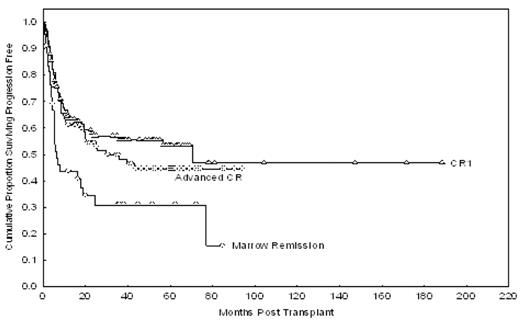Abstract
BACKGROUND: The purpose of this study was to determine the impact of cytogenetics and remission status on outcome of allogeneic stem cell transplantation (alloSCT) conditioned with busulfan and fludarabine based regimens for treatment of acute myeloid leukemia (AML) and myelodysplastic syndrome (MDS).
METHODS: We retrospectively collected data on all consecutive patients (pts) who received busulfan and fludarabine with alloSCT at MD Anderson Cancer Center for AML and MDS between January 2001 and December 2007. All pts received busulfan and fludarabine in myeloablative (busulfan 130 mg/m2 for 4 days and fludarabine 40 mg/m2 for 4 days) or reduced intensity doses. ATG was added to the regimen for unrelated and mismatched related donor transplants. Pts in first complete remission (CR) or advanced CR (2nd or 3rd CR) and also pts with morphologic remission but platelet count <100,000/mcl (termed “marrow remission”) were included. Pts were divided into subgroups according to cytogenetic abnormalities based on the MRC, SWOG, CALGB, and the recently described Dana-Farber (DF) categorization systems. Cox’s regression analysis was used to evaluate the impact of the prognostic factors on overall survival (OS), progression free survival (PFS) and non-relapse mortality (NRM). The cumulative incidence of NRM was estimated considering progression of disease as a competing risk.
RESULTS: 215 pts were included in the analysis with a median age 47 (range 13–69). Four pts were less than 18 years old and 117 (54%) were older than 45 years. Diagnoses were AML (n=176), MDS (n=14) and AML evolving from MDS (n=25). Disease status at alloSCT was; first CR (n=111), advanced CR (n=65) and marrow remission (n=39). Donors were matched related (n= 114), matched unrelated (n=86), 1 antigen mismatched related (n=7), or 1 antigen mismatched unrelated (n=6). Stem cell source was bone marrow (n=84) or peripheral blood (n=131). Median follow-up time of surviving pts was 36 months (range 1.6–85). The 3 years actuarial probabilities of OS and PFS were 59% and 51%, respectively. The 3 years cumulative incidence of NRM was 22%. On univariate analysis, adverse cytogenetics according to the DF scoring system (but not the MRC, SWOG and CALGB classifications) was associated with a significantly lower OS (HR=1.8, P=0.03) and PFS (HR=1.7, P=0.02). Three year PFSs for pts in CR with favorable, intermediate or adverse cytogenetics were 58%, 56% and 49%, respectively (Figure 1). In addition, pts in marrow remission compared to those who were in first or advanced CR with full platelet recovery prior to transplant had a significantly poorer OS (41 vs 63 % at 3 yrs, HR=2.1, P=0.01), and PFS (33 vs 55% at 3 yrs, HR=1.9, P=0.01). Outcomes were comparable for pts in first and advanced CR (Figure 2). AML evolving from MDS was a significant adverse risk factor for OS (HR=1.9, P=0.04) but not for PFS (HR=1.6, P=0.08). On multivariate analysis, pts had the highest mortality rate if they had both a marrow remission and adverse cytogenetics, classified according to the DF system (HR (OS)=3.4, P<0.001; and HR (PFS)=3.2, P<0.001). A diagnosis of AML evolving from MDS remained as a significant adverse factor for OS on multivariate analysis (HR=2.1; P=0.01). Significant adverse prognostic factors for NRM on univariate and multivariate analysis included alloSCT later than one year after diagnosis (HR=2; P= 0.02) and AML evolving from MDS (HR=2.6; P=0.01). There was no impact of cytogenetics on the rate of NRM.
CONCLUSION: Cytogenetic characteristics and remission status before alloSCT correlate with transplantation outcome in MDS or AML pts conditioned with busulfan and fludarabine. This regimen with alloSCT produced improved outcomes compared to published results with standard chemotherapy for pts in the intermediate and high risk cytogenetic groups.
PFS by DF cytogenetic scoring system for patients in first and advanced CR.
PFS by DF cytogenetic scoring system for patients in first and advanced CR.
PFS by remission status prior to transplant.
Disclosures: Andersson:Otsuka Pharmaceuticals: Consultancy. Champlin:PDL Corporation: Research Funding.
Author notes
Corresponding author



This feature is available to Subscribers Only
Sign In or Create an Account Close Modal